Dropshipping In Philippines: A To Z Guide To Start PH Dropshipping
Dive into the heart of e-commerce opportunity with my ultimate guide to dropshipping in the Philippines for 2024! Discover why this vibrant digital marketplace is your golden ticket to entrepreneurial success.
With the global dropshipping market booming and the Philippine online market on the rise, I explore the profitability, strategic supplier insights, and the essential steps to launch your venture.
From the allure of high-profit margins to the dynamic growth of e-commerce in the region, this guide is your essential roadmap to navigating the lucrative world of dropshipping in the Philippines.
Are you ready to seize the moment and thrive in Southeast Asia’s digital economy? Let’s embark on this exciting journey together!


Table of Contents
- Key Takeaways
- Is Dropshipping In Philippines Profitable?
- Best 19 Dropshipping Suppliers in the Philippines
- The No. 1 Tool for all dropshippers – now with AI
- Top 8 Products For Dropshipping In Philippines in 2024
- How To Start Dropshipping In Philippines?
- How To Find Suppliers for Dropshipping in Philipines?
- Why Start Dropshipping in Philippines?
- Pros & Cons Of Dropshipping in the Philippines
- What Online Sellers Think About Dropshipping In Philippines?
- Top 5 Shipping Providers For Dropshipping In Philippines
- Ninja Van
- 2GO Express
- Lalamove
- GrabExpress
- Air21
- 1. What are the legal requirements and tax implications for starting a dropshipping business in the Philippines?
- 2. How does customer service management work in a dropshipping model, especially when dealing with returns or complaints?
- 3. What strategies can be employed to deal with long shipping times, especially when many suppliers might be based overseas?
- Conclusion
Key Takeaways
Dropshipping in the Philippines
- Users will learn about the profitability and growth potential of dropshipping in the Philippines, supported by booming online market projections.
Profitability of Dropshipping
- Insight into the expected profitability margins and the promising online market size, highlighting the financial viability of dropshipping in the region.
Choosing the Best Dropshipping Suppliers Philippines
- Guidance on selecting suppliers, focusing on variety, quality, and supplier support to enhance business operations.
Starting Your Dropshipping Business
- Steps to kickstart a dropshipping venture, from niche selection to supplier partnership.
Top Dropshipping Products for 2024
- Identification of trending products offering high profit margins and market demand insights.
Navigating Challenges
- A realistic view of the challenges involved, including legal, logistical, and customer service aspects, preparing entrepreneurs for the hurdles ahead.
Strategic Planning for Success
- Emphasis on strategic supplier selection, market research, and promotional strategies to build a successful dropshipping business.
Conclusion: A Golden Opportunity
- A concise endorsement of dropshipping in the Philippines as a lucrative venture, balanced with a realistic acknowledgment of the challenges and strategies for overcoming them.
Is Dropshipping In Philippines Profitable?
Yes, dropshipping is considered profitable in the Philippines in 2024. Firstly, the global dropshipping market is expected to reach $301.11 billion in 2024. Plus, the average dropshipping profit is between 15% to 20%.
More importantly, the online market size in the Philippines in 2024, is estimated at USD 15.51 billion, with an expected CAGR of 13.78% reaching up to USD 29.57 billion by 2029.

Best 19 Dropshipping Suppliers in the Philippines
1. NicheDropshipping

NicheDropshipping is great for those who want to sell unique products without ordering a lot at once.
They have all sorts of items, from clothes to tech gadgets, and you don’t have to buy a bunch to get started. They help store your stuff, find what you need, check quality, and send orders to your customers.
Benefits:
- Find unique products easily.
- Create your own brand without hassle.
- Great customer service to help you out.
Downsides:
- Shipping can take a while, depending on where it’s going.
- Special items might cost more.
Costs: They don’t charge to find products for you. You pay for the product and shipping when you order.
2. CJDropshipping

CJDropshipping is another solid choice, especially if you want lots of product options and don’t want to buy a ton upfront. Plus, it offers free dropshipping suppliers Philippines.
They’re helpful whether you’re new to selling online or have been doing it for a while. You can find almost anything here, from beauty products to home goods. They also offer special packaging to make your brand stand out.
Benefits:
- Wide range of products for different niches.
- Helpful customer service is ready to assist.
- Easy to use with eCommerce platforms like Shopify.
Downsides:
- Some items might be pricier because of extra services.
- Shipping time can vary a lot.
Costs: There’s no sign-up fee or monthly charge. You pay based on what you order and the shipping method.
👉 Check out my CJ Dropshipping Review: How Does It Work? Pros & Cons, Comparison & Features.
3. Lazada

Lazada is a big deal in the Philippines, offering a huge selection of products perfect for dropshipping. Its big customer base and full range of services give you a good starting point. From tech to toys and everything in between, they’ve got it. Plus, they offer different payment methods and have a dashboard for managing orders.
Benefits:
- A large variety of items for any niche.
- Trusted platform with lots of visitors.
- Good support for sellers and customers.
Downsides:
- It’s a competitive space with many sellers.
- Watch out for commission fees which can affect pricing.
Costs: Listing products is free. Commission fees depend on what you’re selling.
4. Alibaba

Alibaba is known worldwide and offers a massive selection for all kinds of niches. If you need variety, this is the place.
While it’s more for buying in bulk, you can talk to suppliers about smaller orders. Their Trade Assurance service helps make sure you get what you paid for, and you can check out supplier ratings before you choose.
Benefits:
- Huge selection from lots of suppliers.
- Better prices for more profit.
Downsides:
- Might be tricky to agree on small orders.
- Shipping can take longer, affecting customer happiness.
Costs: No membership fee. Prices and shipping costs vary, so you’ll need to negotiate.
5. FashionTIY

FashionTIY is your go-to for all things fashion, directly offering a vast selection of clothing and accessories for men, women, and kids, along with beauty products and home decor.
It stands out for buying directly from factories, ensuring better prices, offering fast shipping to the Philippines, and providing access to the latest fashion items.
You can start small here because there’s no need to buy a lot of stock upfront.
Pros:
- Tons of fashion-forward products.
- Prices are good since you’re getting items straight from the makers.
Cons:
- Not much room to make the products your own brand.
- Delivery times can change based on what you order and where it’s going.
Cost: Prices change based on what you buy and how much. Shipping costs also vary.
6. Bags on Demand
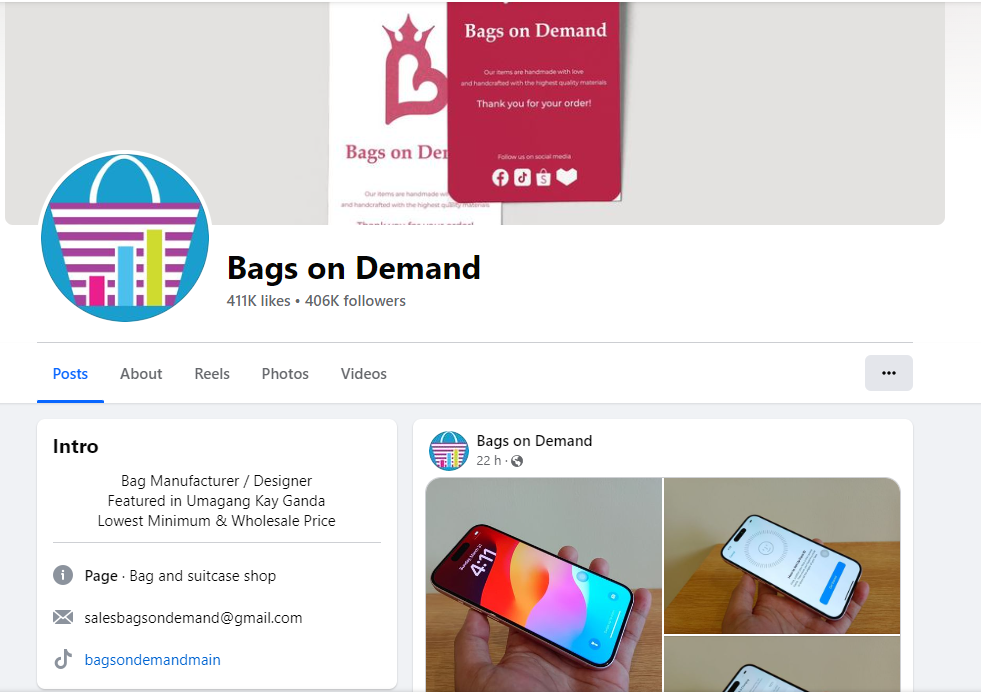
Bags on Demand specializes in a wide range of bags, from stylish handbags to practical backpacks, making it a great pick if you want to sell bags without worrying about ordering too much stock at once.
With a large variety of trendy and functional bags, no minimum order requirement, and reliable service including a user-friendly ordering system and personalized customer support, it’s ideal for businesses of all sizes.
Pros:
- Lots of trendy bag options.
- Easy to get started due to no minimum order.
Cons:
- Only a good fit if bags are your main thing.
- Bag trends can change, so what’s in stock might not always be what’s hot.
Cost: Prices are competitive, and you’ll see them once you sign up with them. They’re set up to grow with your business needs.
7. MamaBearPH

MamaBearPH is perfect for those looking to sell items for moms and babies, offering a big selection, from maternity wear to baby gear and toys, and letting you order as little as you want to start.
It focuses on mom-and-baby products with no minimum order, making it easy to test the waters, and provides reliable customer service for any issues that may arise.
Pros:
- Specialized products for a niche market.
- Great for starting small and scaling up.
Cons:
- Only covers mom and baby items, which might not appeal to everyone.
- Product availability can be hit or miss.
Cost: Competitive pricing with clear costs listed. Check their website for the latest prices and product availability.
8. Lynns Fashion Store

Lynns Fashion Store offers a wide selection of women’s clothing and accessories, known for its personal touch and reliable service, making them a great partner for Philippine-based dropshippers.
It’s highlighted by its wide range of women’s fashion, no minimum for retail orders, membership programs for better deals, and is suitable for varied order sizes.
Pros:
- Diverse styles for different tastes.
- Suitable for varied order sizes.
Cons:
- Limited mainly to the Philippines.
- The focus is mostly on women’s items.
Cost: Membership fees apply for wholesale buyers, but you get access to special pricing. Competitive retail prices help you keep a good profit margin.
9. Shopee
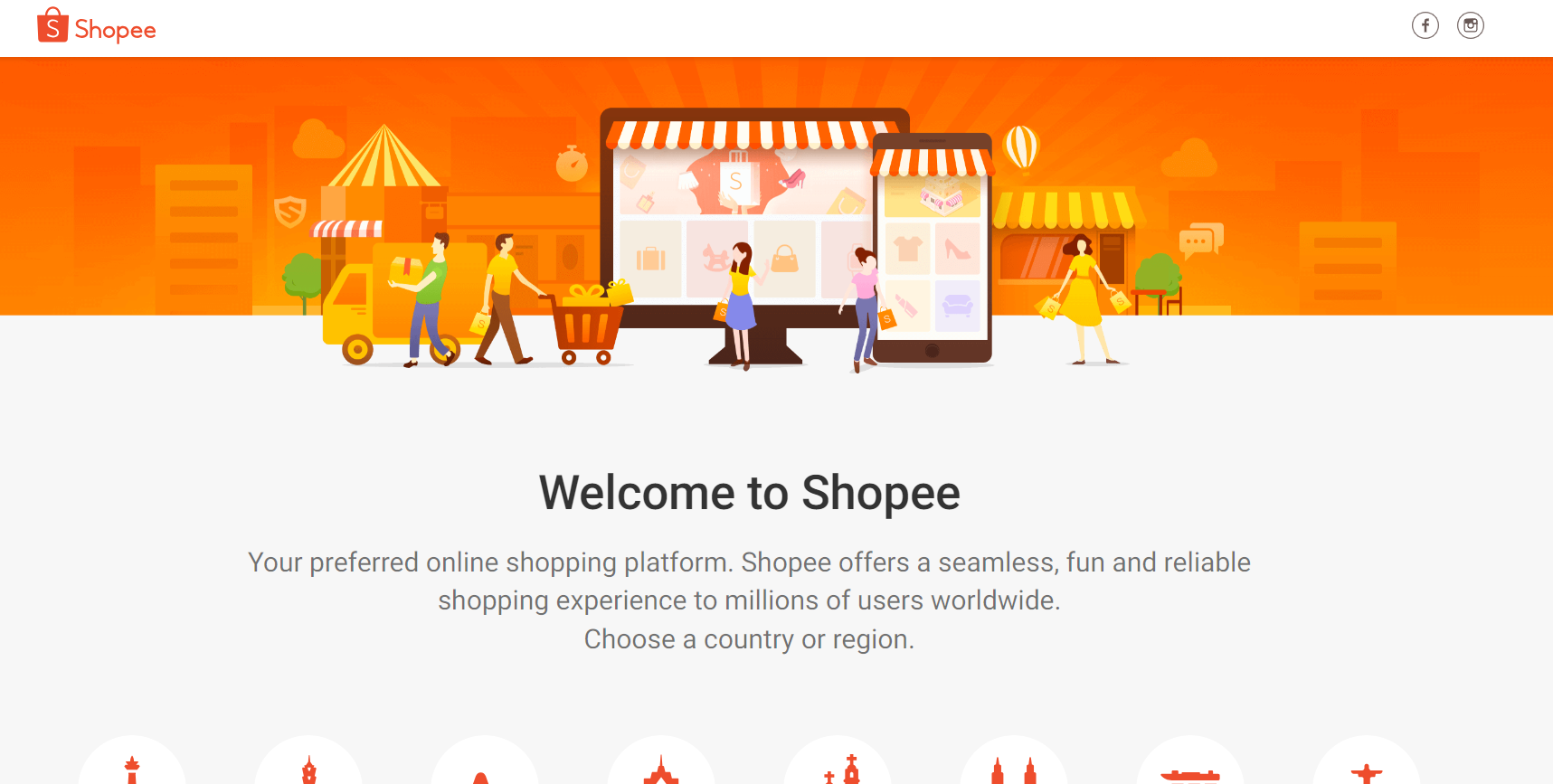
Shopee is a leading eCommerce platform in the Philippines that caters to a wide array of product categories suitable for various niches, making it a reliable source for sourcing products.
It’s recognized for its extensive customer reach within the Philippines, trustworthy platform reducing buyer skepticism, and access to sales and marketing tools to enhance your store’s performance, all with no MOQ requirement.
Pros:
- Large potential customer base.
- A trusted platform that encourages buying.
- Tools to boost your store’s success.
Cons:
- High competition in popular categories.
- Commission fees can affect your prices.
Cost: You pay a commission on sales, which varies by category. Advertising on Shopee also costs extra.
10. Spocket

Spocket could be a game-changer for your dropshipping business in the Philippines, offering a variety of high-quality products from clothing to home decor.
Partnering mainly with suppliers from the US and EU, Spocket stands out for those aiming to distinguish their offerings in the dropshipping market in the Philippines.
- Benefits:
- Access to exclusive deals and discounts on premium products.
- Branded invoicing for a personalized touch.
- Ability to place sample orders to ensure product quality.
- Downsides:
- Higher pricing compared to bulk purchase suppliers.
- A limited number of suppliers from Asia, potentially increasing shipping times.
- Costs: Plans range from a free trial to various paid options, supporting growth at different stages of your dropshipping venture in the Philippines.
👉 Also, check out my review Spocket Dropshipping: The Ultimate Guide to Dropshipping With Spocket in the EU & US.
11. Banggood

Banggood offers an extensive product range, emerging as a robust partner for dropshipping in the Philippines.
Its constantly updated inventory ensures your store stays competitive.
- Benefits:
- A wide range of products across multiple categories.
- User-friendly platform, ideal for beginners.
- Marketing support with access to professional photos and descriptions.
- Downsides:
- Variable shipping times could affect customer satisfaction.
- Lack of brand recognition for some products, impacting niche markets reliant on brand loyalty.
- Costs: Tier-based discount structure that grows with your dropshipping sales, offering competitive product prices for a healthy profit margin.
12. Modalyst

Modalyst simplifies product importing for dropshipping in the Philippines, offering a seamless connection with high-quality suppliers, especially from the US and EU.
- Benefits:
- Direct communication with suppliers, enhancing product selection and quality assurance.
- No minimum order quantity (MOQ), providing flexibility to test the market.
- Easy integration with eCommerce platforms, streamlining operations.
- Downsides:
- 5% transaction fee even with the free plan, impacting margins.
- Limited access to all dropshipping suppliers Philippines under the free plan.
- Costs: Offers plans from $0/month (Hobby) to $90/month (Pro), catering to various stages of business development.
13. Printify
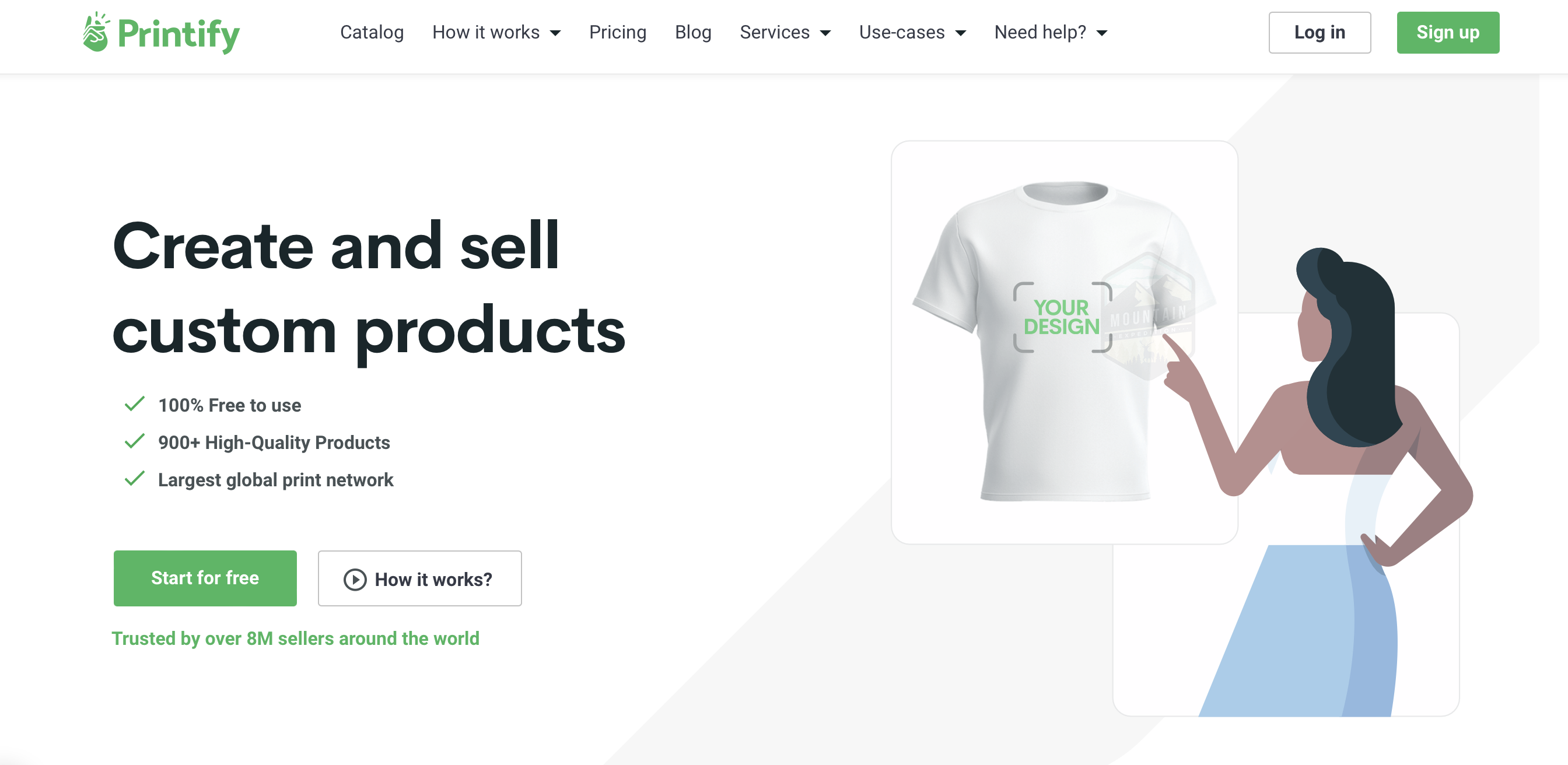
Printify connects you with a network of print-on-demand companies worldwide, offering a vast range of customizable products.
- Benefits:
- Extensive options for product printing, materials, and pricing flexibility.
- Integration with Shopify, Etsy, eBay, and more for a streamlined process.
- 20% discount on all products under the premium plan, enhancing profit margins.
- Downsides:
- Relies on third-party dropship suppliers, which can vary in quality and delivery times.
- Shipping rates vary between suppliers, requiring careful planning for costs.
- Costs: Subscription plans include free, premium ($29/month), and enterprise options, with shipping partnerships across major carriers like USPS and FedEx.
👉 Read my comparison of Printful vs Printify – Which Platform Is Better for print on demand dropshipping?
14. Printful

Printful is recognized for its high-quality print-on-demand services, offering a broad range of customizable products and integrated solutions for dropshipping in the Philippines.
- Benefits:
- High-quality printing and a wide range of techniques.
- Worldwide shipping, white-label, and branding options.
- Integrated with major e-commerce platforms, facilitating easy setup.
- Downsides:
- Pricing may be higher, affecting profit margins.
- Express shipping options are available but at higher rates.
- Costs: Charges are per item plus shipping, with no minimum order requirements. Promotional discounts are available for bulk purchases, aiding in cost management.
👉 Check out Print on Demand Dropshipping: Apliiq vs Printful – Which is Better?
I hope this comprehensive overview helps illuminate the features, benefits, downsides, and costs associated with the best dropshipping suppliers Philippines. Thus, it provides valuable insights for your dropshipping business in the Philippines.
15. eSources

eSources is ideal for finding a variety of suppliers for dropshipping in the Philippines, catering to different niches with a focus on reliable service. It’s especially welcoming for startups due to its no minimum order policy, enabling effective market testing without large initial investments.
- Benefits:
- Access to a diverse range of products suitable for various niches, perfect for tailoring your dropshipping inventory in the Philippines.
- No minimum order requirement, offering flexibility in inventory management for dropshipping startups in the Philippines.
- User-friendly interface for quick supplier comparison, making it easier to navigate the dropshipping landscape in the Philippines.
- Downsides:
- Limited number of suppliers with warehouses in the Philippines, which may extend shipping times for your dropshipping orders.
- High competition in popular niches, poses challenges to maintaining product uniqueness in the Philippine dropshipping market.
- Costs: Operates on a subscription basis with different tiers to suit your business needs, allowing for scalability in your dropshipping operations in the Philippines.
16. DHgate
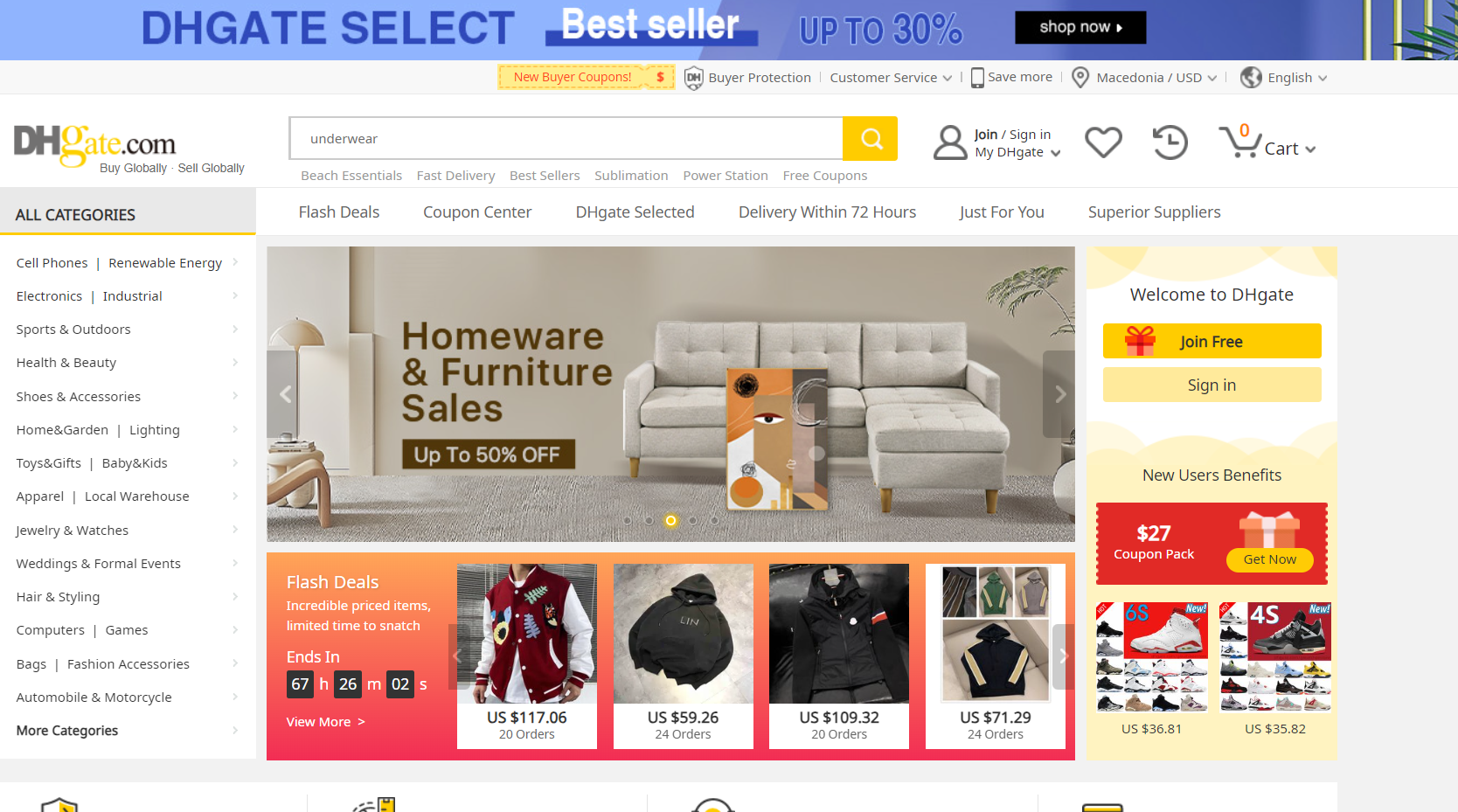
DHgate offers a wide range of product categories, making it a versatile option for dropshipping in the Philippines.
Its no minimum order quantity facilitates easy start-up and scaling, appealing to dropshippers at any stage.
- Benefits:
- Diverse Inventory: Offers products across numerous categories, providing ample choice for your dropshipping business in the Philippines.
- User-Friendly Interface: Simplifies the product selection and ordering process for efficient dropshipping in the Philippines.
- Local Warehouses: Enhances shipping speed within the Philippines, benefiting your dropshipping delivery times.
- Downsides:
- Mixed Supplier Quality: Requires diligence in selecting suppliers to ensure product quality for your dropshipping store in the Philippines.
- Shipping Times: Despite local warehouses, some products may still ship internationally, leading to longer waits for dropshipping orders in the Philippines.
- Costs: Competitive pricing with options for discounts on bulk orders, supporting profitability for dropshipping in the Philippines.
17. Dropify

Dropify positions itself as a leading cash-on-delivery dropshipping service in the Philippines, integrating with platforms like Lazada and Shopee. It supports a broad range of niches, enhancing your dropshipping options in the Philippines.
- Benefits:
- No setup fee, allowing for a cost-effective start to dropshipping in the Philippines.
- Niche versatility, offers products across numerous categories suitable for dropshipping in the Philippines.
- Downsides:
- Limited global reach, focusing primarily on the Philippine market, which may restrict the international expansion of your dropshipping business.
- Service costs for additional features could accumulate, impacting the overall cost-efficiency of dropshipping in the Philippines.
- Costs: Follows a pay-as-you-go model for services used, providing clear cost management for your dropshipping operations in the Philippines.
18. SaleHoo

SaleHoo serves as both a supplier directory and plugin, featuring a market research lab to assist Philippine dropshippers in identifying high-demand, profitable products.
- Benefits:
- Wide product selection from reliable suppliers, enhances the credibility of your dropshipping store in the Philippines.
- An easy-to-use system supported by a helpful customer service team, smoothing the path for dropshipping in the Philippines.
- Downsides:
- No free plan is available, requiring an upfront investment to access the benefits for dropshipping in the Philippines.
- Many products are sourced from AliExpress, which may limit exclusivity in your dropshipping offerings in the Philippines.
- Costs: SaleHoo is recommended for ensuring supplier reliability and gaining insights into profitable dropshipping niches in the Philippines.
19. AliExpress

AliExpress offers a massive selection of products at competitive prices, suitable for both individual and bulk purchases, making it a versatile source for dropshipping in the Philippines.
- Benefits:
- Large selection of affordable, diversified goods, ideal for expanding your dropshipping inventory in the Philippines.
- Free registration and seamless integration with platforms like Shopify, simplifying the start-up process for dropshipping in the Philippines.
- Downsides:
- Some vendors have a history of selling substandard products or making inaccurate claims, which could affect the reputation of your dropshipping business in the Philippines.
- Costs: Dropshipping with AliExpress is cost-effective, with no upfront fees, facilitating an easy entry into the dropshipping market in the Philippines.
💡 Tip: Discover the 9 Reasons About Why Is AliExpress So Cheap [Truth Revealed]
Top 8 Products For Dropshipping In Philippines in 2024
T-shirts with Local Designs
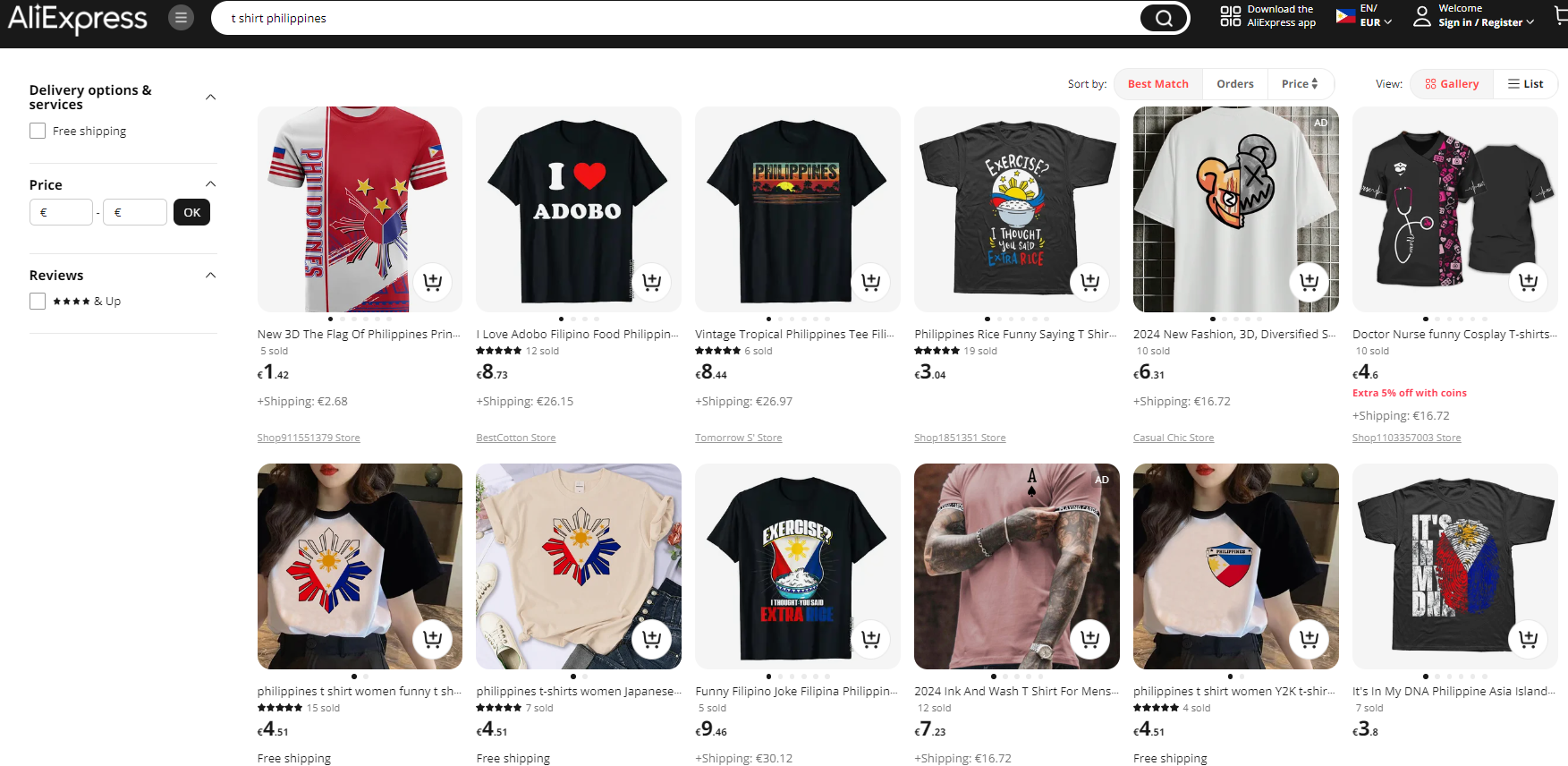
T-shirts with locally inspired designs offer a unique appeal to Filipino consumers, tapping into their cultural pride. Dropshipping these products eliminates the need for inventory management and upfront production costs.
You can partner with local artists or suppliers to customize designs, providing a competitive edge.
With a price range of $4 to $16 and a product cost range of $1.60 to $6, these shirts offer potential profit margins of 60% to 70%.
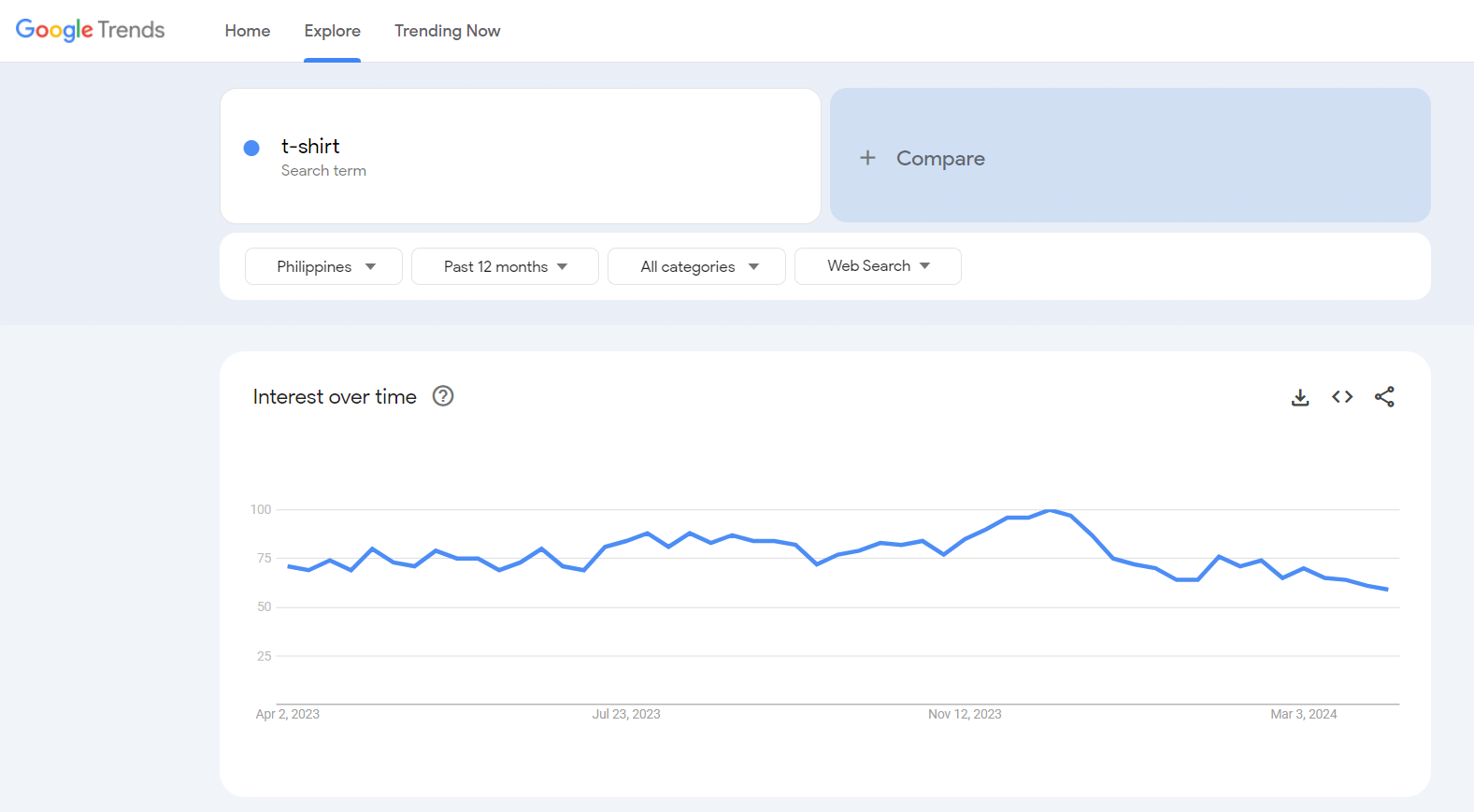
Budget Smartphones
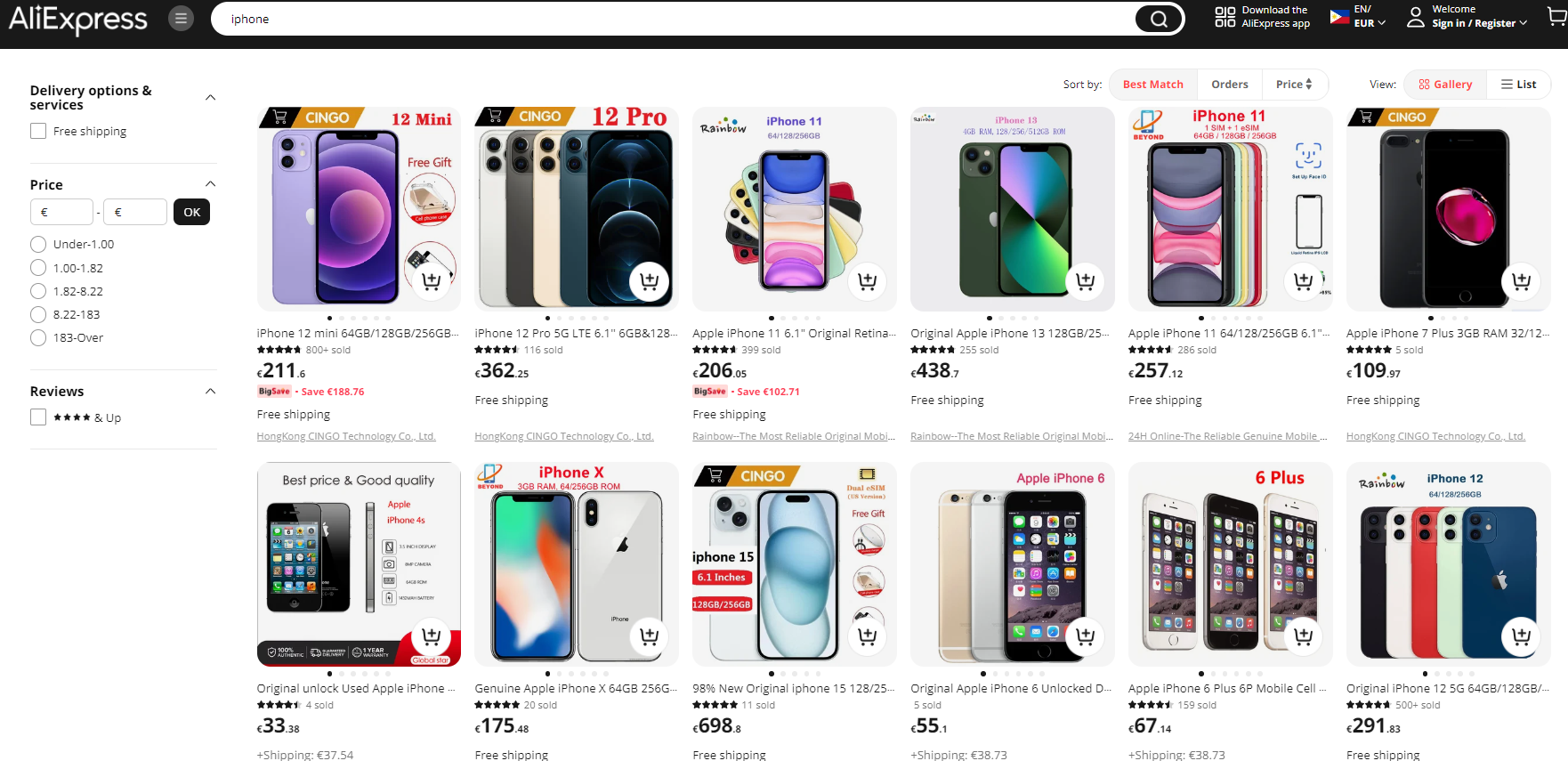
With a price range of $60 to $200 and a product cost range of $30 to $120, these smartphones offer potential profit margins of 30% to 50%.
Budget smartphones cater to the growing demand for affordable yet functional devices in the Philippines.
By dropshipping smartphones, you can offer a wide range of models without the burden of stocking inventory.
Also, partnering with reputable suppliers ensures quality products and timely delivery, enhancing customer satisfaction.

Activewear (e.g., Yoga Pants, Sports Bras)

With the rising interest in health and fitness, activewear has become a lucrative niche in the Philippines. Dropshipping activewear allows you to offer a diverse selection of products without the hassle of managing inventory or production.
Collaborating with reliable suppliers ensures consistent supply and quality, attracting fitness enthusiasts seeking trendy yet affordable apparel.
With a price range of $10 to $50 and a product cost range of $4 to $20, these activewear items offer potential profit margins of 50% to 60%.
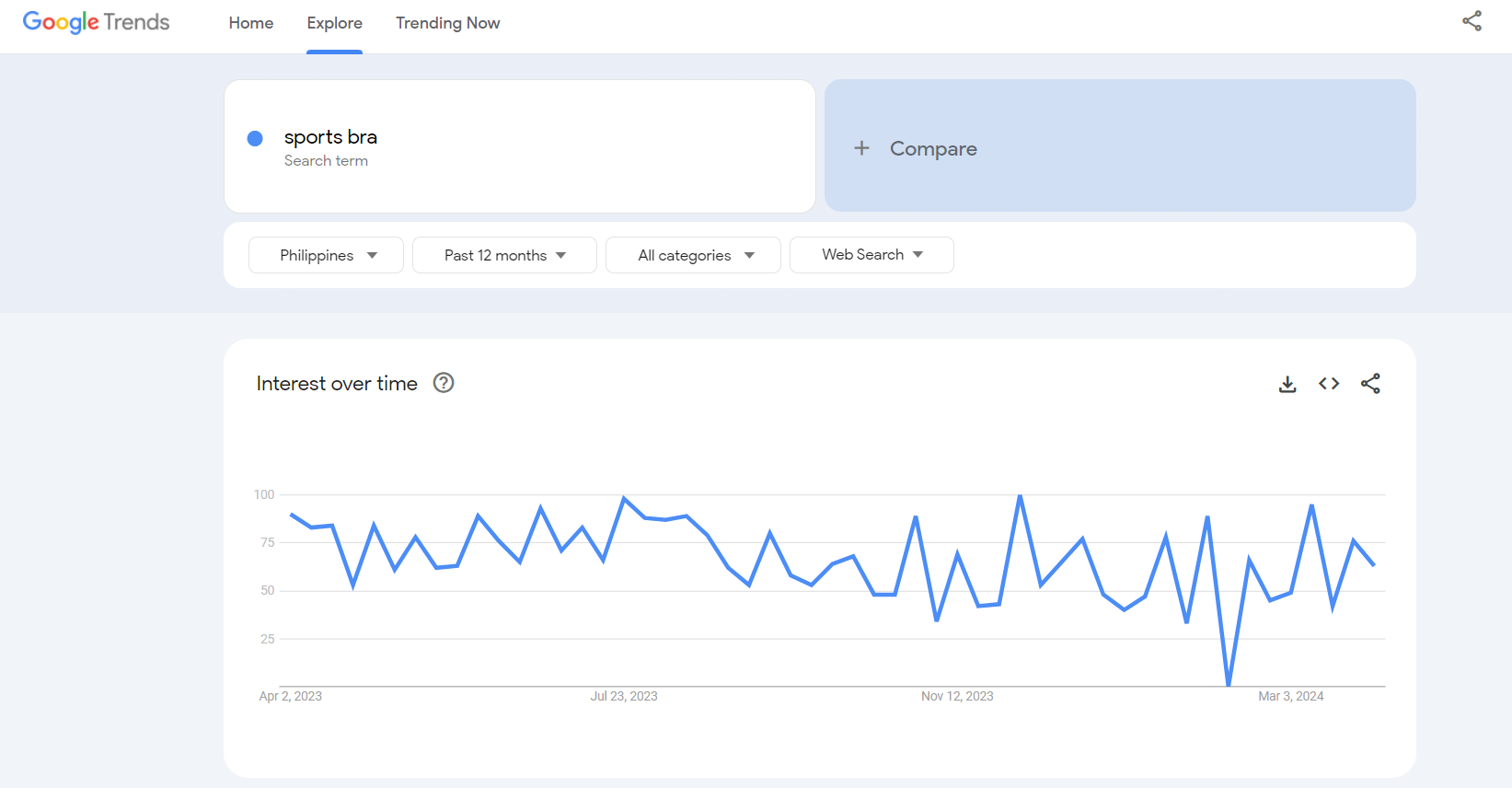
Wall Art

Wall art emerges as a significant trend in 2024, particularly with the increasing prevalence of remote work and the desire to personalize living spaces.
With a product cost of approximately $6.00, dropshippers can retail wall art for $37.00+, yielding a profit margin of $31.00. This category highlights consumers’ growing interest in transforming their homes into unique and inspiring environments.
Google Trends data indicates a high demand for wall art, reflecting consumers’ interest in personalizing their living spaces.

Oil Diffuser

The demand for oil diffusers underscores consumers’ emphasis on wellness and home ambiance.
With a product cost of around $10.00, dropshippers can set retail prices at $18.00+, resulting in a profit margin of $8.00. These aromatic wonders cater to individuals seeking to create soothing atmospheres, aligning with the trend of turning homes into havens of relaxation.
Google Trends data shows a consistent demand for oil diffusers, reflecting consumers’ emphasis on wellness and creating soothing home environments.

Thermos

In today’s fast-paced world, thermoses symbolize convenience and sustainability for consumers on the go.
With a product cost of approximately $9.00, dropshippers can retail thermoses for $21.00+, yielding a profit margin of $12.00. The appeal of thermoses lies in their ability to keep beverages hot or cold for hours, catering to outdoor enthusiasts, office-goers, and students alike.
Moreover, Google Trends data indicates a consistent demand for thermoses, reflecting consumers’ need for convenience and sustainability on the go.

Insulated Travel Tumbler

The rising sustainability trend drives the appeal of insulated travel tumblers, which offer eco-conscious consumers a stylish and practical solution.
With a product cost averaging $8.00, dropshippers can set retail prices at $20.00+, resulting in a profit margin of $12.00. These tumblers address the dual need for environmental friendliness and beverage temperature retention, making them a must-have accessory
Also, Google Trends data highlights a growing interest in insulated travel tumblers, reflecting consumers’ desire for eco-friendly and stylish beverage solutions.

LED Face Masks

Beauty and personal care products, particularly those promoting self-care and wellness like LED face masks, are in high demand. This category offers significant potential profit margins, with some products boasting over 50% profit margins.
Also, Google Trends data underscores a consistent demand for LED face masks, reflecting consumers’ growing interest in natural and organic beauty products and wellness solutions.
Dropshippers can tap into this lucrative market, catering to consumers’ growing interest in natural and organic beauty products.

How To Start Dropshipping In Philippines?
Want to sell popular items online? Let’s dive into how to kick off your dropshipping business in the Philippines, step by step.
Step 1 – Choose Your Niche
First, identify a specific market or type of product you want to sell. Think about who you are targeting and what interests them.
So, you can spend time exploring online shops for inspiration. Also, using Google Trends to check for popular items like “wall art” can give you a good start.
Thus, you can set your region on “Philippines” precisely, or just leave it to “Worldwide”.

Moreover, you can use tools like Adserea, Minea, PipiAds, etc., for deeper market insights.

Step 2 – Find Your Suppliers
Finding trustworthy suppliers is crucial. You need suppliers who deliver quality products, fair prices, and quick delivery.
Thus, assess their customer service and return policies to ensure they align with a great customer experience.
Dropshipping.com can be a helpful resource for finding verified suppliers, offering a directory to narrow down options based on your needs.

Moreover, you can filter your search based on category, supplier location, product costs, shipping, etc.
Also, you can get valuable information about each supplier, like MOQ, shipping costs, product costs, order processing time, contact information, and more.
Step 3 – Set Up Your Online Store
Time to launch your store. A user-friendly and attractive website is essential. Therefore, you need to ensure your site has clear menus and detailed product descriptions and uses high-quality images or videos.
Shopify is a popular choice for its ease of use and design options tailored to dropshipping.

Other platforms like WooCommerce, BigCommerce, Wix, etc., are also available for setting up your store.
Step 4– Promote Your Business
Promotion is key to drawing in customers and boosting sales. So, I advise you to use social media marketing on social platforms like Facebook, Instagram, and TikTok to engage with potential customers.
So, partnering with influencers or bloggers can extend your reach. Additionally, creating videos and starting a blog related to your niche can boost your SEO and attract more traffic to your dropshipping store.
How To Find Suppliers for Dropshipping in Philipines?
Looking for dropshipping suppliers can be tricky.
Sometimes, it’s tough to tell who’s trustworthy and who’s not.
But, there are some ways to hunt down good suppliers for dropshipping:
➡ Start with Your Own Research
The first step is you! Just use a web browser like Google and search for dropshipping suppliers in your area.
For instance, if we’re looking for dropshipping suppliers in the Philippines, you could type “best dropshipping suppliers Philippines” and look through the results.

But, it can be hard to tell if they’re legit or not.
And sometimes, the really good suppliers don’t focus much on having a fancy website or a big catalog. So, looks can be deceiving.
If you’re okay with digging around yourself and not spending money, this could be a way. But be careful, it might end up costing more in time and trouble later.
➡ Online Directories like Dropshipping.com
Dropshipping.com lists tons of trustworthy suppliers.
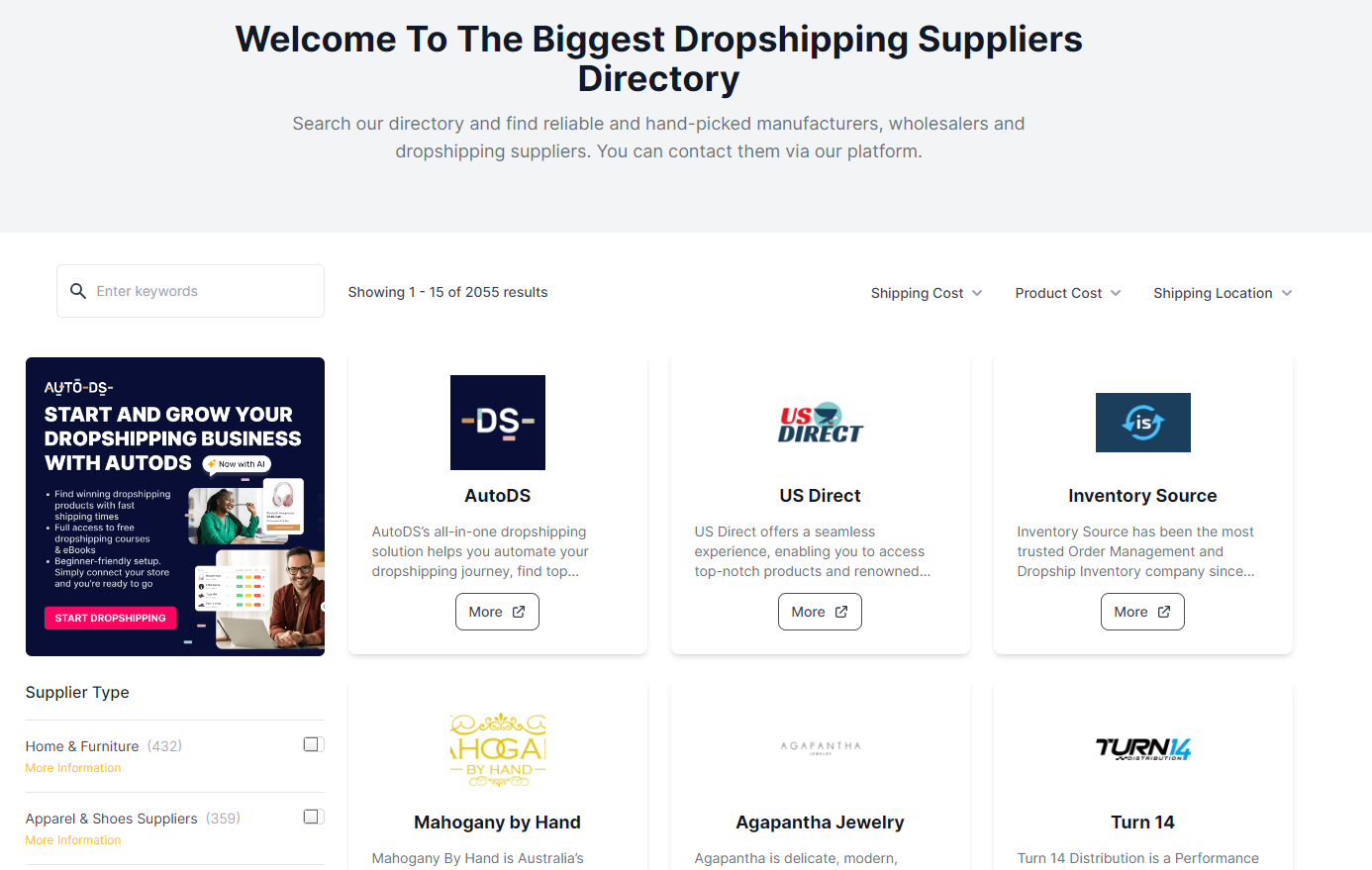
You can search by product type, shipping costs, where the supplier is, and more.
You can also see important info about each supplier, like minimum orders, product prices, how long it takes to process orders, and how to get in touch with them.

And, if you get stuck, the Dropshipping.com team is there to help you find or contact a supplier.
➡ Check on Online Marketplaces
Sites like Alibaba, AliExpress, or eBay let you look for suppliers talk to them, and order from them.
Here, it’s smart to look at the supplier’s ratings and reviews before choosing them.
For example, the Up Assistant, an AliExpress Chrome Extension, helps you understand seller ratings better.
It looks at more than just feedback, considering how long the seller has been on AliExpress and how well they talk to buyers.
This tool gives a better view of how good a seller is, helping you make smarter choices.
For example, if you’re looking at dropshipping yoga mats, Up Assistant shows a rating for each seller right on the product image.
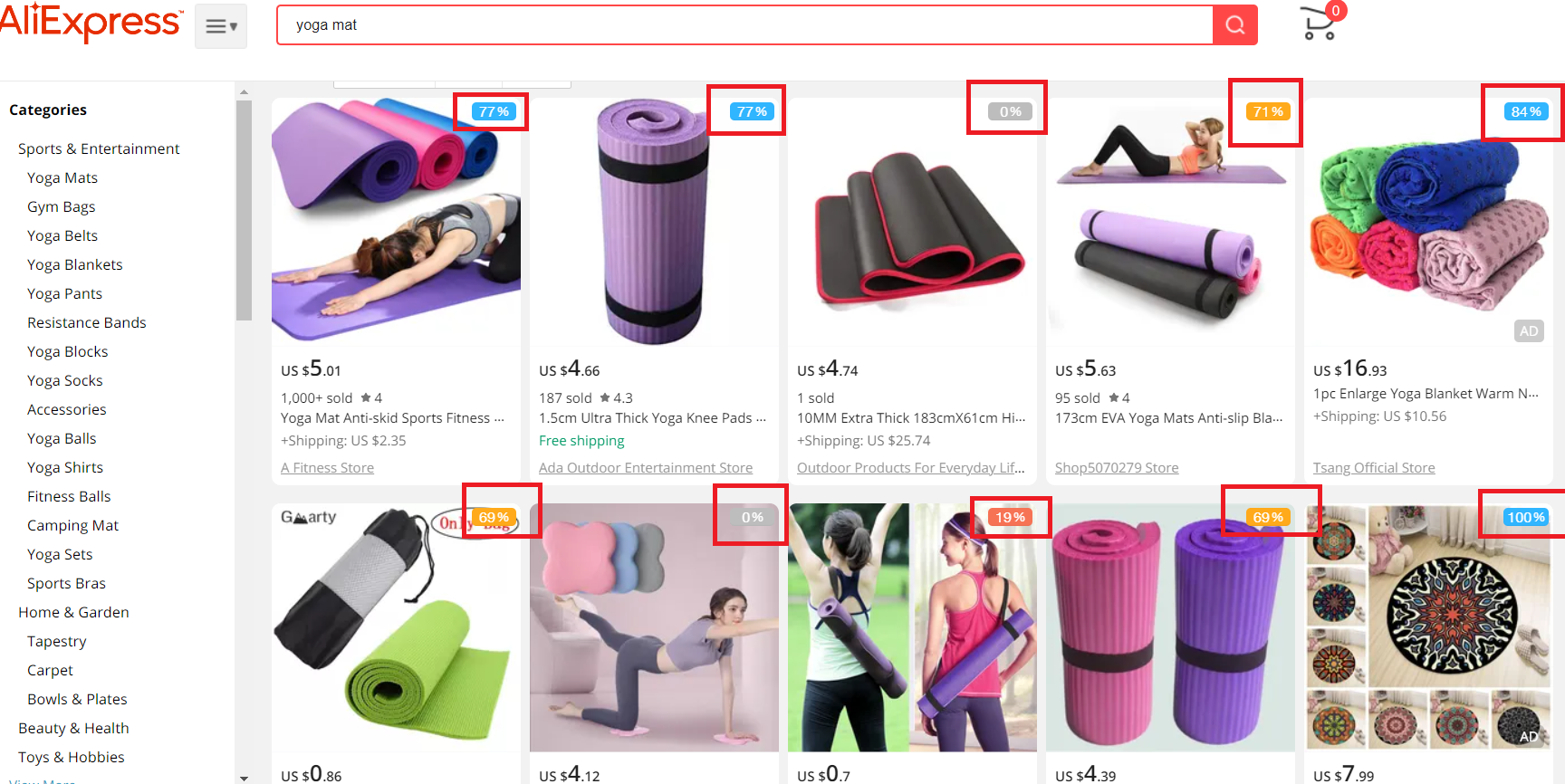
And, for more details, you can click on the product to get a full report on its page.
➡ Look on Social Media & Online Communities
Another way to find reliable suppliers is by looking on social media.
For example, I’m in a Facebook group for dropshipping in the Philippines – it’s a goldmine for finding good suppliers.

Thus, members share their own experiences with different suppliers in various niches.
Moreover, you can check on Reddit channels about dropshipping in Philippines. Here you can find valuable information and even real-life stories about it.

Why Start Dropshipping in Philippines?
Next, I will list the main reasons why starting a dropshipping business in Philippines is worth it.
🔸 Growing Digital Market
The Philippines has a rapidly expanding digital market. Thus, as I already mentioned the online market size in the Philippines in 2024 is estimated at USD 15.51 billion, with an expected CAGR of 13.78% reaching up to USD 29.57 billion by 2029.
With a young, tech-savvy population that’s increasingly comfortable with online shopping, the potential customer base is vast and still growing.
This digital trend is supported by the widespread use of social media and mobile devices, making it easier to reach and market to potential customers.
🔸 Low Startup Costs
Dropshipping allows you to start a business without needing a large amount of capital. You don’t need to purchase inventory upfront, rent physical space, or pay for storage.
This low barrier to entry makes it particularly appealing in the Philippines, where entrepreneurs can start a business with limited resources.
🔸 Wide Range of Products
The flexibility in product selection means you can adapt to the latest trends and demands without financial risk.
Whether it’s fashion, gadgets, or health and wellness products, you can cater to various interests of the Filipino market, which is known for its diverse tastes and openness to new products.
🔸 Strategic Location
The Philippines is strategically located in Southeast Asia, offering the potential to tap into both local and regional markets.
While the primary focus might be selling to customers within the country, dropshipping also provides the foundation to expand to nearby markets in the future.
🔸 Supportive Online Platforms
There’s an abundance of online platforms and tools available that cater to Filipino entrepreneurs.
From local e-commerce platforms that facilitate easy selling and shipping within the country to international platforms that offer access to a wide range of suppliers worldwide, the infrastructure is there to support a dropshipping business.
🔸 Increasing Internet and Mobile Penetration
With the country’s increasing internet and mobile penetration rates, reaching customers online has never been easier.
This connectivity allows dropshippers to market their products effectively through various online channels, including social media, e-commerce platforms, and their own websites.
Pros & Cons Of Dropshipping in the Philippines
Dropshipping in the Philippines, like in any market, comes with its set of benefits and challenges.
Understanding these can help you navigate the dropshipping landscape more effectively.
So, here are some concrete pros and cons specific to the Philippines:
Pros
✅ High Internet Usage and Social Media Engagement
The Philippines has one of the highest rates of social media usage globally.
This presents a vast opportunity for dropshippers to use platforms like Facebook, Instagram, and TikTok for marketing and sales.
✅ English Proficiency
With a high level of English proficiency among the population, you can easily communicate with international suppliers and customers.
This also makes it easier to create marketing materials and manage customer service.
✅ E-commerce Adoption
E-commerce is rapidly growing in the Philippines, with more consumers becoming comfortable with online shopping.
This trend is beneficial for dropshipping businesses looking to capture a growing market.
✅ Young Consumer Base
The country has a young demographic that is tech-savvy, making it easier to market trending products, especially in tech, fashion, and beauty.
Cons
❌ Logistical Challenges
The Philippines is an archipelago with over 7,000 islands, which can present logistical challenges in terms of shipping and delivery.
Ensuring timely and cost-effective delivery can be more complicated compared to countries with more straightforward geographic layouts.
❌ Internet Connectivity Issues
Despite high internet usage, the Philippines still faces issues with internet speed and reliability in certain areas.
This can affect the online shopping experience for customers and the operation of your dropshipping store.
❌ Competition with Local and International Sellers
The dropshipping market in the Philippines is becoming increasingly competitive. Competing with both local and international sellers requires unique marketing strategies and finding niche products to stand out.
❌ Payment Gateway Limitations
While there are well-established payment gateways in the Philippines, there’s still a significant portion of the population that prefers cash transactions.
This preference can limit the reach of your dropshipping store to only those comfortable with online payments.
❌ Consumer Protection Concerns
Filipinos are becoming more cautious about online scams, which can lead to hesitancy in purchasing from new or unknown online stores.
Building trust and establishing a reliable brand is crucial but can take time.
❌ Regulatory and Taxation Complexity
Navigating the regulatory and taxation landscape for e-commerce businesses in the Philippines can be complex.
Staying compliant requires understanding local laws and regulations, which might involve additional costs and legal considerations.
What Online Sellers Think About Dropshipping In Philippines?
If you’re considering venturing into dropshipping in the Philippines, it’s crucial to navigate both its challenges and opportunities with insight.
Here’s my advice to fellow entrepreneurs and curious minds on how to make the most out of this business model:
Understand the Challenges

- Be Prepared for Shipping and Handling Fees: The major stumbling block in the Philippines is the prolonged shipping times and additional post office fees. These can deter customers and eat into your profits. Factor these costs into your pricing strategy without compromising on competitiveness.
- Adapt to Customer Preferences: Filipinos prefer cash on delivery (COD) to avoid scams and ensure product authenticity. While this can be seen as a hurdle, it’s also an opportunity to build trust by offering flexible payment options.
- Consider the Geography: The Philippines is an archipelago, which means shipping costs can vary significantly. Tailor your strategy to address these geographical challenges, perhaps by focusing on areas where logistics are more favorable or by finding suppliers with efficient distribution networks.
Common Mistakes
Selling in US Dollars and Its Impact on Dropshipping in the Philippines
When it comes to dropshipping in the Philippines, it’s essential to understand the local preference for currency. Filipinos generally prefer to deal with transactions in their own currency.
While receiving money in USD is welcomed, spending in it is another story entirely. This preference means that displaying prices in Philippine pesos becomes crucial if you’re targeting Filipino customers with your dropshipping store.
The perception of affordability changes drastically when prices are listed in US dollars; to a Filipino shopper, a price in USD is synonymous with expensiveness, regardless of the actual cost.
Consequently, showcasing prices in the local currency not only cater to customer preferences but also avoids the potential loss of interest the moment they spot a dollar sign.
Moreover, the assumption often follows that products priced in USD are imported, which can be a deterrent. Despite a general fondness for imported goods, Filipinos tend to shy away from purchasing these items online on a whim.
The preference leans towards products that seem local or are bought for them by relatives working abroad.
Therefore, for effective dropshipping in the Philippines, it’s advisable to price all products in Philippine pesos, signaling to potential buyers that the items are readily available within the country.
The Strategy Around Shipping Costs
Another critical aspect to consider in the realm of dropshipping in the Philippines is the approach to shipping costs.
For example, the standard shipping fee on popular platforms like Lazada is around ₱50 per item, setting a baseline expectation among Filipino shoppers.
Charging substantially more, such as $20 (or about ₱1,000), can significantly hinder your store’s appeal. So, a more effective strategy involves incorporating the shipping cost into the product’s total price and then highlighting “free shipping” as a benefit.
This method, while essentially redistributing costs, can significantly enhance the attractiveness of your offer by aligning with customer expectations for shipping fees.
However, the notion of “free shipping” can be contentious, with opinions divided on its ethical implications. If transparency is a priority for you, a straightforward alternative is to communicate that the item’s price already includes shipping.
This approach maintains clarity and honesty with your customers, making your dropshipping business in the Philippines more appealing by addressing concerns about shipping costs directly and effectively.
Leverage the Opportunities

- Capitalize on the Digital Economy: The Philippines has a strong digital infrastructure, with widespread internet access and a booming smartphone market. Use online marketing strategies and social media to reach your target audience effectively.
- Select the Right Suppliers: With many excellent suppliers catering to both local and global markets, choose those that align with your business goals. Companies like Alibaba, Lazada, and FashionTIY can be good partners, offering a wide range of products and reliable shipping options.
- Diversify Your Product Range: The availability of a vast array of products from suppliers means you can tap into various niches. This flexibility allows you to adapt to market trends and consumer demands quickly.
Before You Dive In

- Prepare Your Budget Wisely: Starting a dropshipping business isn’t trivial in terms of investment. Ensure you have around $1000 to cover the initial expenses, including product samples, website development, and marketing campaigns.
- Do Your Homework: Conduct thorough market research to understand the local e-commerce landscape, consumer behavior, and the specific challenges of shipping within the Philippines.
- Strategize for Shipping: Develop a shipping strategy that minimizes costs and delivery times. This might include choosing suppliers with strategic warehouses or those who offer favorable shipping terms.
- Pick Reliable Suppliers: Your choice of suppliers can make or break your business. Look for those with a proven track record of reliability and who can navigate the logistical challenges unique to the Philippines.
In essence, while dropshipping in the Philippines comes with its set of unique challenges, especially around logistics and consumer trust, the opportunities within the growing digital market are significant
Moreover, you can join the top Philippines E-Commerce & Dropshipping Community group and learn about dropshipping in the Philippines. Or the Official Website: OJMD Solutions & Dropshipping Philippines .
Top 5 Shipping Providers For Dropshipping In Philippines
Next, I will list you the top 5 shipping providers for dropshipping in Philippines.
Ninja Van

Ninja Van stands out as a key player in the Southeast Asian logistics sector, offering hassle-free deliveries that have made it one of the region’s largest and fastest-growing last-mile delivery couriers.
The company’s presence in the Philippines is marked by its flexibility in parcel pickups and the convenience of COD service, making it a top choice for eCommerce businesses looking for reliable logistics solutions .
2GO Express

2GO Express is recognized for its comprehensive range of services, including both domestic and international delivery options.
As the sole retail partner for FedEx in the Philippines, 2GO Express boasts an extensive network that caters to over 220 international destinations, offering real-time tracking and a wide array of logistics solutions.
Lalamove

Lalamove began its journey as a van-hiring service in Hong Kong and has since expanded its operations across Mainland China, Southeast Asia, and India.
Specializing in express delivery, the company prides itself on its ability to offer rapid, reliable logistics solutions to a vast customer base, making it a go-to for businesses operating within the Greater Manila Area, Pampanga, and Cebu.
GrabExpress

As part of the widely recognized Grab platform, GrabExpress delivers on-demand, premium delivery services within key urban areas like Metro Manila and Cebu City.
Known for its convenience and speed, GrabExpress caters to businesses and individuals needing same-day or next-day delivery, leveraging the Grab app for easy booking and real-time tracking.
Air21

Air21’s history as a customs brokerage firm has evolved into a leading provider of air express and logistics services in the Philippines.
The company specializes in handling electronics, gadgets, and products from multinational brands, offering an array of services that include door-to-door delivery and online billing, supported by a comprehensive online and mobile booking system.
For courier services, companies like LBC Express, DHL Express, and JRS Express are also prominent, offering a variety of services that prioritize delivery speed, reliability, and customer satisfaction within the Philippines and beyond.
1. What are the legal requirements and tax implications for starting a dropshipping business in the Philippines?
Starting a dropshipping business in the Philippines requires navigating legal and tax regulations that ensure your business operates within the law.
Entrepreneurs must register their business with the Department of Trade and Industry (DTI) if it’s a sole proprietorship, or with the Securities and Exchange Commission (SEC) for partnerships and corporations.
This legal step is essential for acquiring the necessary permits and licenses.
Regarding taxation, businesses are required to register with the Bureau of Internal Revenue (BIR). As of my last update, dropshipping businesses are subject to income tax, value-added tax (VAT), or percentage tax, depending on their annual revenue.
💡 Tip: Read about Dropshipping Taxes and Payments – Guide For Beginners.
It’s crucial to keep accurate financial records and possibly consult a tax professional to comply with the tax obligations and benefit from any applicable tax exemptions or deductions.
The Philippine tax code is complex, and staying informed about changes in tax regulations is vital for avoiding penalties and optimizing your business’s financial health.
2. How does customer service management work in a dropshipping model, especially when dealing with returns or complaints?
Customer service management in a dropshipping business model requires a proactive and transparent approach, especially since the seller does not have direct control over inventory.
When dealing with returns or complaints, communication is key. Therefore, it’s important to establish clear return and refund policies in advance and make sure these are communicated to customers before purchase.
In case of issues, sellers should act as the liaison between the customer and the supplier, managing communication to resolve the issue satisfactorily.
Thus, this might involve arranging for the return shipment to the supplier, negotiating a refund or replacement on behalf of the customer, and keeping the customer informed throughout the process.
Building strong relationships with suppliers is crucial, as it ensures they are responsive and cooperative when issues arise.
Offering exceptional customer service, including quick responses to inquiries and proactive problem-solving, can help mitigate the limitations of not managing inventory directly and maintain customer trust and satisfaction.
3. What strategies can be employed to deal with long shipping times, especially when many suppliers might be based overseas?
To address the challenge of long shipping times in dropshipping, especially with overseas suppliers, several strategies can be effective. Setting realistic expectations by clearly communicating potential delivery times on product pages and during the checkout process can help manage customer expectations.
Thus, offering comprehensive tracking information allows customers to monitor their orders, providing transparency and reducing anxiety about delivery times.
Exploring suppliers with warehouses closer to your target market can significantly reduce shipping times.
Some suppliers might have local fulfillment centers in the Philippines or nearby regions, facilitating quicker deliveries. Negotiating faster shipping options with suppliers, even if it involves a higher cost, can be a worthwhile investment to enhance customer satisfaction.
Moreover, offering a range of shipping options gives customers the choice between longer, more economical shipping or paying extra for faster delivery.
Also, employing these strategies can help mitigate the impact of long shipping times on your dropshipping business’s success and customer satisfaction.


Conclusion
The vibrant digital landscape of the Philippines presents a promising opportunity for aspiring entrepreneurs looking to dive into the world of dropshipping in 2024.
This guide has highlighted the profitability of dropshipping in the region, underscored by a booming online market projected to reach USD 29.57 billion by 2029.
The Philippine e-commerce market is ripe for entrepreneurs due to its digital savvy population, growing internet and mobile penetration, and a wide range of product niches that cater to the diverse tastes of Filipino consumers. Suppliers like NicheDropshipping, CJDropshipping, and Lazada offer varied benefits from unique product access to integration with popular e-commerce platforms, making it easier for dropshippers to find their footing in this competitive market.
However, potential dropshippers should be mindful of the challenges, including navigating the legal and tax frameworks, managing customer service effectively, especially with returns and complaints, and dealing with long shipping times.
These are critical factors that can impact the success of a dropshipping business in the Philippines.
In my opinion, the opportunity to start a dropshipping business in the Philippines is compelling, given the country’s dynamic digital economy and the low startup costs associated with this business model.
Entrepreneurs have a golden chance to leverage the growing e-commerce sector, tapping into a market that is both large and expanding.
However, success in this venture requires a detailed understanding of the local market, strategic planning, and a proactive approach to overcoming logistical and operational challenges.
In conclusion, while dropshipping in the Philippines offers a lucrative avenue for digital entrepreneurship, it demands careful consideration of the market dynamics, customer expectations, and supply chain complexities.
With the right strategies and a commitment to overcoming the inherent challenges, dropshipping can indeed be a golden ticket to entrepreneurial success in Southeast Asia’s thriving digital economy.













![The Top 21 3PL Companies Compared [2024 List & Guide]](https://images.weserv.nl/?url=https://prod-dropshipping-s3.s3.fr-par.scw.cloud/2024/03/Frame-3922469.jpg&w=420&q=90&output=webp)